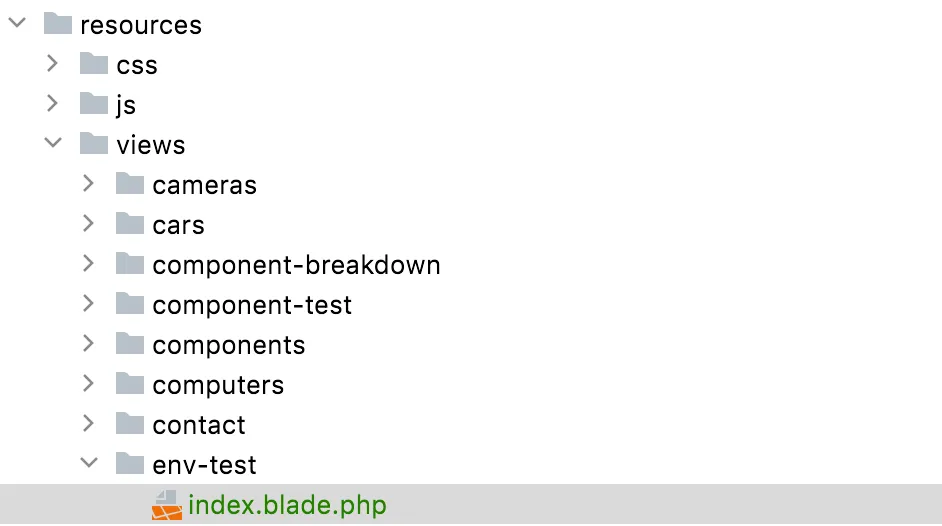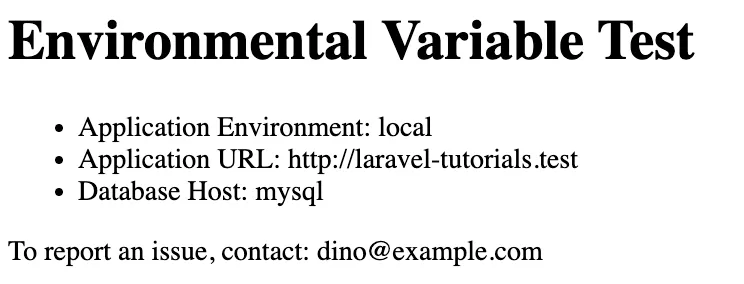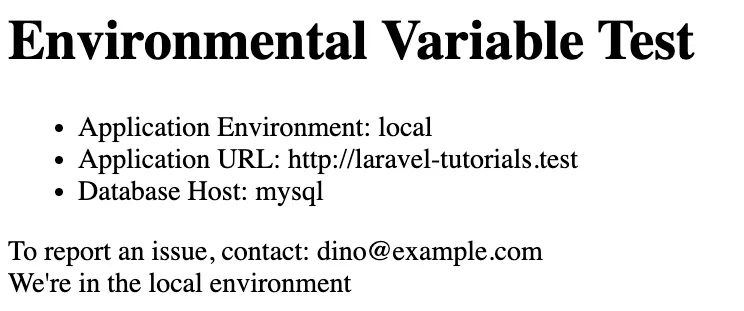
Environment checks made simple
There comes a time when you want to use environmental variables in your Blade components. But, how do you do it? There are a couple of different ways. We’ll take a look at the env() function first and then the directive itself.
https://www.dinocajic.com/laravel-p64-rendering-jason-in-blade/
Using the env() function
Let’s open our .env file and take a look at some of the variables that are already defined there.
APP_NAME=Laravel
APP_ENV=local
APP_KEY=base64:X2mYdNpqK29Z21Fb9Dx6PDa6Jwd6k4ThXuP+VYd9dco=
APP_DEBUG=true
APP_URL=http://laravel-tutorials.test
LOG_CHANNEL=stack
LOG_DEPRECATIONS_CHANNEL=null
LOG_LEVEL=debug
DB_CONNECTION=mysql
DB_HOST=mysql
DB_PORT=3306
DB_DATABASE=laravel_tutorials
DB_USERNAME=sail
DB_PASSWORD=password
We can access any of those variables with our env() function. Create a new Blade file and a route to access it.

Route::get('/env-test', function () {
return view('env-test.index');
});
Inside of your blade file, let’s see if we can display any of those variables.
<h1>Environmental Variable Test</h1>
<ul>
<li>Application Environment: {{ env('APP_ENV') }}</li>
<li>Application URL: {{ env('APP_URL') }}</li>
<li>Database Host: {{ env('DB_HOST') }}</li>
</ul>

We can even define our own environmental variables in the .env file. For example, let’s say you define an environmental variable called DEVELOPER_EMAIL with the value dino@example.com.
In your Blade component, you can access the DEVELOPER_EMAIL environmental variable using the env() function like this:
<div>
To report an issue, contact: {{ env('DEVELOPER_EMAIL') }}
</div>

When you view the Blade component, it will display the value of the DEVELOPER_EMAIL environmental variable, which in this case would be dino@example.com.
The env() function can be used to access any environmental variable from the .env file.
@env directive
There exists an environmental directive in Blade, but it’s different than the env() function. You can use environment directives to conditionally include or exclude code in Blade components based on the current environment (i.e. local, staging, production). It’s just a short way to check the APP_ENV variable.
For example,
@env('local')
We're in the local environment
@endenv
@env('staging')
We're in the staging environment
@endenv
@env('production')
We're in the production environment
@endenv

Since our APP_ENV is set to local, it will display the content inside of the local conditional.
For production environments, we also get the @production directive.
@production
We're in production
@endproduction
If you start changing the .env variables, you will have to restart your dev environment. For me it’s as simple as restarting the Docker container.
Laravel Series
Continue your Laravel Learning.
Serve structured data straight from Blade
Laravel – P64: Rendering Json In Blade
Part 64 of our Laravel fundamentals series shows you how to safely render JSON from Blade templates. Learn encoding strategies, escaping rules, inline scripts, and performance tips to deliver structured data to front-end frameworks with zero headaches.
Environment checks made simple
Laravel – P65: Env Directives In Blade
Part 65 of our Laravel fundamentals series clarifies the difference between the Blade @env directive and Laravel’s environment() helper. Learn when to use each, avoid pitfalls, and keep your codebase environment-aware, efficient, and secure.
Style smart, render dynamic
Laravel – P66: Conditional Styling In Blade
Part 66 of our Laravel fundamentals series explores dynamic class and style binding in Blade. Use ternaries, class directive, and attribute merging to toggle styles based on data, user roles, or environment, keeping components clean and responsive.

